Are you ready to embark on an unforgettable hiking adventure in Joshua Tree National Park? Look no further! In this article, I will provide you with everything you need to know about Joshua Tree hiking, from the best trails to seasonal tips and important safety considerations. Whether you’re a beginner or an experienced hiker, there’s something for everyone in this unique desert landscape.
Key Takeaways:
- Explore the top trails in Joshua Tree National Park
- Plan your hikes according to seasonal conditions
- Take necessary safety precautions for a safe hiking experience
- Experience the historical significance and geological wonders of the park
- Observe the diverse wildlife and enjoy scenic viewpoints
Easy Hiking Trails in Joshua Tree

If you’re looking for a beginner-friendly hiking experience in Joshua Tree National Park, there are several easy hiking trails that offer stunning views and a chance to connect with nature. These trails are ideal for those who want to explore the park at a more relaxed pace or for families with young children. Here are some of the top easy hiking trails in Joshua Tree:
Arch Rock Trail
The Arch Rock Trail is a short and accessible hike that leads to a natural arch formation. The trail is approximately 0.5 miles long and is perfect for all skill levels. Along the way, you’ll be able to admire the unique rock formations that dot the landscape and capture some great photos at the iconic Arch Rock.
Bajada Trail
The Bajada Trail is a 1.1-mile loop that offers a scenic stroll through the desert. This trail is known for its abundant wildflowers during the spring season, making it a favorite among nature enthusiasts. The trail is relatively flat, with minimal elevation gain, making it suitable for hikers of all abilities. Keep an eye out for the diverse desert flora and fauna that thrive in this area.
Barker Dam Trail
The Barker Dam Trail is a popular trail that takes you on a 1.5-mile loop around a historic water storage reservoir. Along the way, you’ll pass through a picturesque desert landscape filled with Joshua Trees and rocky outcrops. This trail provides a unique opportunity to learn about the cultural history of the area and admire the ancient petroglyphs carved into the rocks.
These easy hiking trails in Joshua Tree National Park offer an opportunity to immerse yourself in the beauty of the desert landscape while enjoying a leisurely hike. Remember to bring plenty of water, wear sunscreen, and stay on the designated trails to respect the delicate ecosystem of the park.
Challenging Hiking Trails in Joshua Tree
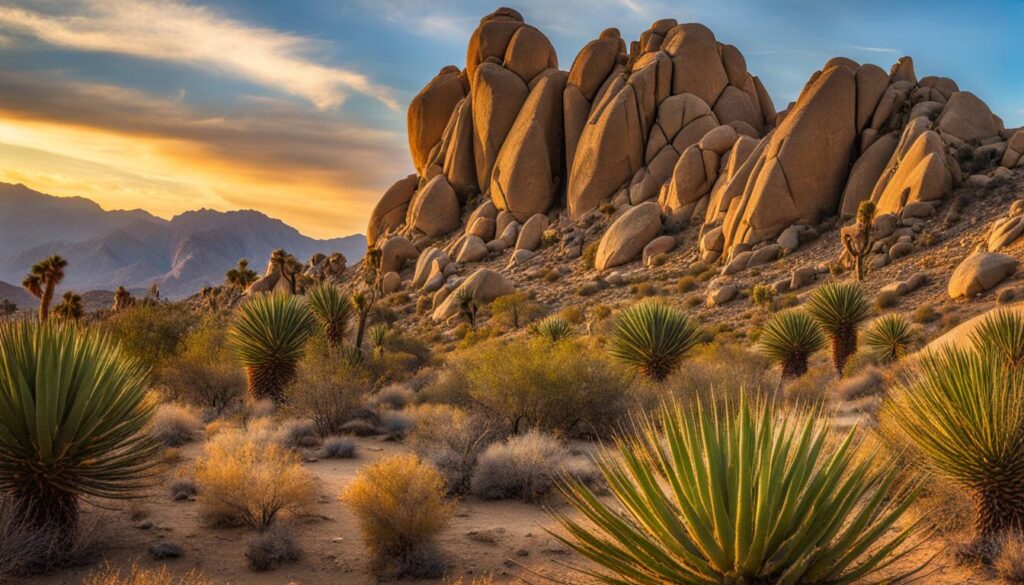
If you’re an experienced hiker seeking a challenge, Joshua Tree National Park offers a range of challenging hiking trails that will push your limits. These trails are designed for those looking to test their skills and endurance, with steep climbs, rugged terrain, and advanced route-finding. It’s important to come prepared with proper hiking gear and navigation tools to ensure your safety on these trails.
Popular Challenging Hiking Trails
Some of the popular challenging hiking trails in Joshua Tree National Park include:
- Boy Scout Trail: This trail spans approximately 16 miles and takes you through varied landscapes, including forests of Joshua Trees and expansive desert vistas. It requires advanced route-finding skills and is recommended for experienced hikers.
- Lost Horse Mine Trail: This 4-mile trail leads to the well-preserved remains of a historic gold mine. It offers panoramic views of the park and is known for its wildflower displays in the spring.
- Warren Peak Trail: This trail is located in the less-visited northern part of the park and offers stunning views of the surrounding mountains and desert. It is a 6-mile round trip with a steep climb to the summit.
These challenging trails not only offer incredible views and a chance to test your hiking skills but also provide an opportunity to explore the more remote and less crowded areas of the park. Just remember to plan your hike carefully, bring plenty of water, and be aware of the potential risks associated with hiking in challenging terrain.
Hiking in Joshua Tree: Summer vs Winter
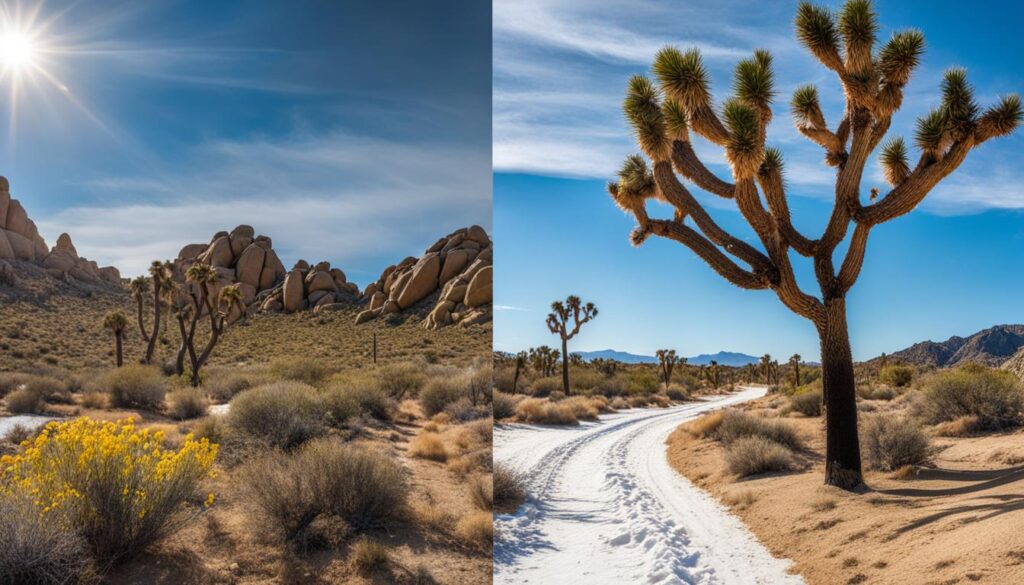
When planning a hiking trip to Joshua Tree National Park, it’s important to consider the differences in hiking conditions between the summer and winter seasons. The contrasting temperatures and weather patterns can significantly impact your hiking experience.
Summer Hiking in Joshua Tree
In the summer months, Joshua Tree National Park experiences scorching temperatures, often exceeding 105 degrees Fahrenheit (40 degrees Celsius). These extreme heat levels can pose serious risks to hikers, making it essential to take precautions. It is recommended to avoid hiking between 10 am and 5 pm when the sun’s intensity is at its peak. Instead, plan your hikes for early morning or late afternoon when the temperatures are relatively cooler. Additionally, it’s crucial to stay hydrated by bringing plenty of water and wearing lightweight, breathable clothing.
Winter Hiking in Joshua Tree
During the winter season, temperatures in Joshua Tree National Park are more moderate, ranging from the 40s to the 70s Fahrenheit (4 to 21 degrees Celsius). While the days can be pleasant for hiking, it’s important to be prepared for cold nights, as temperatures can drop below freezing. Dressing in layers and bringing warm clothing is essential to stay comfortable. It’s also advisable to check the weather forecast before starting your hike as unexpected storms or heavy rainfall can occur during the winter months.
Spring and Fall: Peak Hiking Seasons
Spring and fall are generally considered the ideal seasons for hiking in Joshua Tree National Park. During these periods, the temperatures are milder, ranging from the 60s to the 80s Fahrenheit (15 to 27 degrees Celsius), creating comfortable hiking conditions. The park’s vegetation also comes alive with colorful wildflowers and blooming Joshua Trees, adding to the scenic beauty of the trails. Spring and fall are popular times to visit, so expect larger crowds and consider making advanced reservations for campsites or accommodations.
Historical Significance and Geological Wonders of Joshua Tree
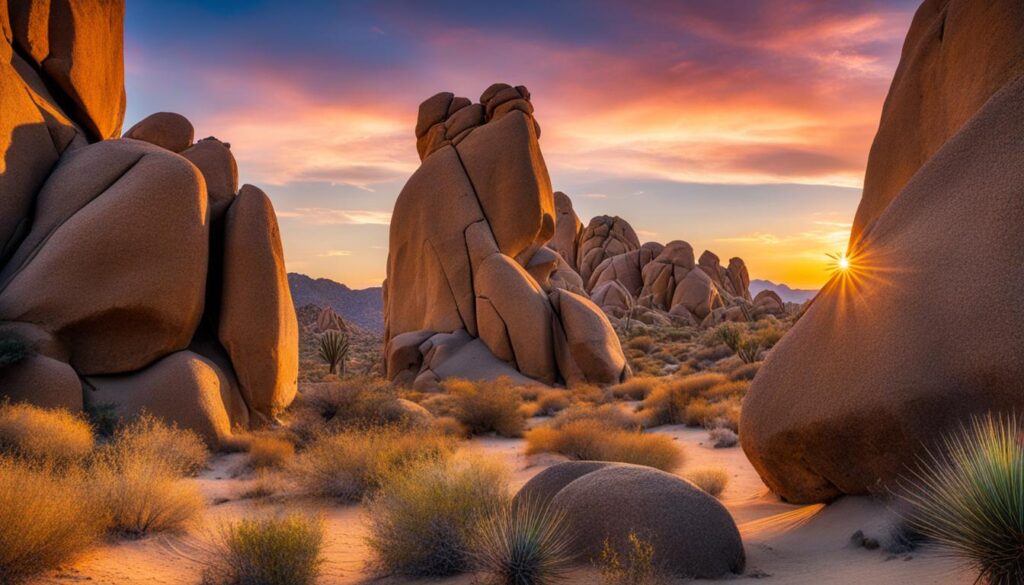
Joshua Tree National Park is not only a haven for hikers but also a place of historical significance and breathtaking geological wonders. As you venture through the park’s trails, you’ll come across remnants of Native American culture, old mining structures, and traces of its rich ranching history.
The park’s historical sites offer a glimpse into the past, allowing you to immerse yourself in the region’s heritage while surrounded by the stunning beauty of the desert landscape. From ancient rock art to abandoned mines, each site tells a story of the people who once called this area home.
Joshua Tree National Park is also renowned for its geological formations that have been millions of years in the making. Towering Joshua Trees, massive boulder piles, and panoramic vistas are just a few examples of the stunning features that await you. The unique landscape showcases the intricate work of nature, leaving you in awe of the forces that have shaped this remarkable environment.
Historical Sites in Joshua Tree National Park
| Site | Description |
|---|---|
| Keys View | A viewpoint that offers panoramic vistas of the Coachella Valley, San Andreas Fault, and the Salton Sea. |
| Barker Dam | A historical and cultural site with a water reservoir built by early ranchers. It features Native American petroglyphs. |
| Lost Horse Mine | An abandoned gold mine that provides a glimpse into the park’s mining history. |
Exploring the historical significance and geological wonders of Joshua Tree National Park adds a deeper appreciation for the natural beauty that surrounds you. As you hike through the park, take a moment to reflect on the history and marvel at the awe-inspiring landscapes that make this destination truly remarkable.
Wildlife in Joshua Tree National Park
Exploring Joshua Tree National Park offers more than just scenic views and challenging trails; it also provides the opportunity to encounter a diverse array of wildlife. The park is home to various desert-dwelling animals that have adapted to survive in this arid environment. From elusive desert tortoises to agile kangaroo rats, the wildlife in Joshua Tree National Park showcases the resilience and beauty of nature.
One of the most iconic animals in the park is the desert tortoise. This reptile, known for its hardy shell and slow-paced lifestyle, can often be spotted in the park’s desert regions. It is essential to observe these tortoises from a distance and refrain from touching or disturbing them as they are a protected species.
In addition to tortoises, Joshua Tree National Park is also home to a variety of mammalian wildlife. Visitors may have the opportunity to encounter bighorn sheep, known for their impressive horns and ability to navigate the park’s rocky terrain. Other mammal species include coyotes, bobcats, and jackrabbits.
“The wildlife in Joshua Tree National Park showcases the resilience and beauty of nature.”
The park is also a haven for bird enthusiasts, boasting a diverse avian population. Birdwatchers may spot species such as the western bluebird, roadrunner, and the ladder-backed woodpecker. The park’s unique landscape and vegetation provide a habitat for these feathered inhabitants.
| Wildlife Species | Description |
|---|---|
| Desert Tortoise | An iconic reptile known for its hardy shell and slow-paced lifestyle. It is important to observe them from a distance. |
| Bighorn Sheep | Majestic mammals with impressive horns, well-adapted to navigate rocky terrain. |
| Coyotes | Native canines with a distinct howl, often seen roaming the park in search of food. |
| Bobcats | Elusive and solitary felines, skilled hunters that thrive in the park’s diverse ecosystem. |
| Jackrabbits | Large, long-legged hares that are well-adapted to the desert environment. |
| Western Bluebird | A beautiful songbird with vibrant blue feathers, often spotted perched on desert shrubs. |
| Roadrunner | An iconic bird known for its distinctive appearance and ability to run swiftly across the desert floor. |
| Ladder-backed Woodpecker | A woodpecker species with a unique pattern on its back and a distinct drumming sound. |
When encountering wildlife in Joshua Tree National Park, it is important to remember that these animals are protected, and their habitats should be respected. Observing from a distance and avoiding any interference ensures the preservation of their natural behaviors and contributes to their long-term survival in the park.
Scenic Viewpoints in Joshua Tree National Park
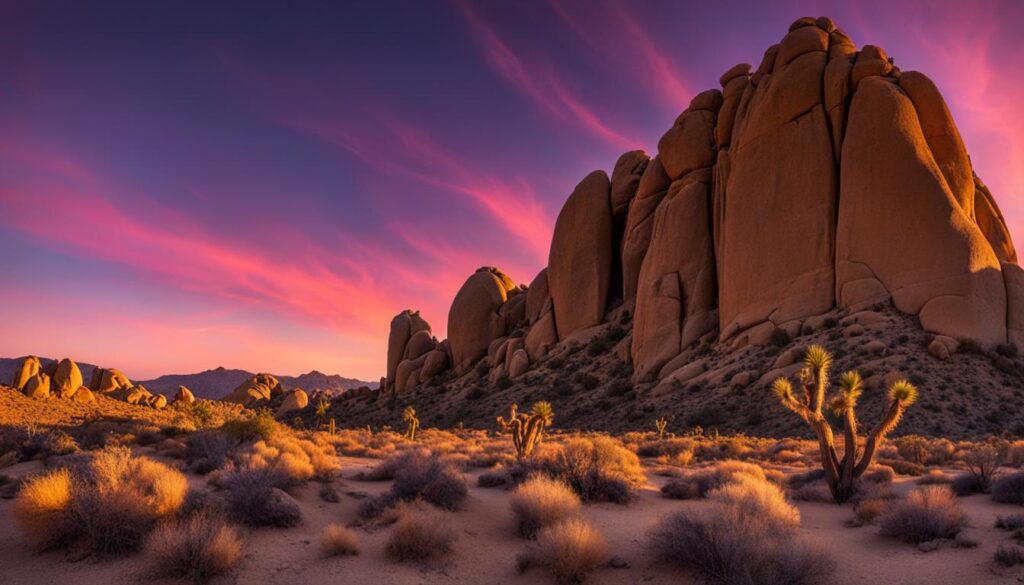
Exploring the stunning scenic viewpoints in Joshua Tree National Park is a must-do for any hiking enthusiast. These viewpoints offer breathtaking vistas that showcase the unique beauty of the desert landscape, rock formations, and distant mountain ranges. Whether you’re looking for a picturesque spot to snap some photos or simply want to immerse yourself in the natural wonders of the park, these scenic viewpoints will not disappoint.
One of the most popular viewpoints in the park is Keys View. Located at an elevation of 5,185 feet, this viewpoint provides a panoramic view of the Coachella Valley, the Salton Sea, and even as far as Mexico on a clear day. It’s a truly awe-inspiring sight that shouldn’t be missed.
Another noteworthy viewpoint is Ryan Mountain. Although reaching the top requires a moderately strenuous hike, the effort is well worth it. From the summit, hikers are rewarded with 360-degree views of the surrounding landscape, including the iconic Joshua Trees and jumbled rock formations that make Joshua Tree National Park so unique.
For those seeking a less crowded viewpoint, the High View Trail offers a quieter experience. This trail takes you to a rocky outcrop where you can enjoy uninterrupted views of the park’s vast expanse. It’s an ideal spot to contemplate the beauty of the desert in solitude.
Jessica’s Tip:
If you’re visiting Joshua Tree National Park, make sure to allocate enough time to visit these scenic viewpoints. They provide a different perspective of the park’s landscape and are perfect for capturing memorable photos. Remember to bring your camera and prepare for stunning vistas that will leave you in awe.
Trip Planning for Joshua Tree Hiking

Proper trip planning is essential for a successful hiking experience in Joshua Tree National Park. Before embarking on your hike, it is important to research the trail you plan to explore, including its distance, elevation gain, and estimated time. Check weather conditions and be aware of any trail closures or restrictions. It is also recommended to inform a friend or family member about your hiking plans and expected return time. Consider bringing essential items like a map, plenty of water, appropriate clothing, a first-aid kit, and navigation tools.
When planning your trip, it’s crucial to take into account the season and its associated challenges. The summer months in Joshua Tree can be scorching hot, with temperatures exceeding 105 degrees Fahrenheit. It’s best to avoid hiking between 10 am and 5 pm during this time as the heat can be dangerous. In winter, the temperatures drop significantly, and nights can be freezing. Spring and fall are considered the peak seasons for comfortable hiking conditions, with milder temperatures and pleasant weather.
Furthermore, it is important to practice Leave No Trace principles while hiking in Joshua Tree National Park. This means packing out all trash, respecting wildlife, staying on designated trails, and avoiding disturbing the natural environment. By following these guidelines, we can help preserve the beauty and integrity of the park for future generations to enjoy.
Safety Tips for Joshua Tree Hiking
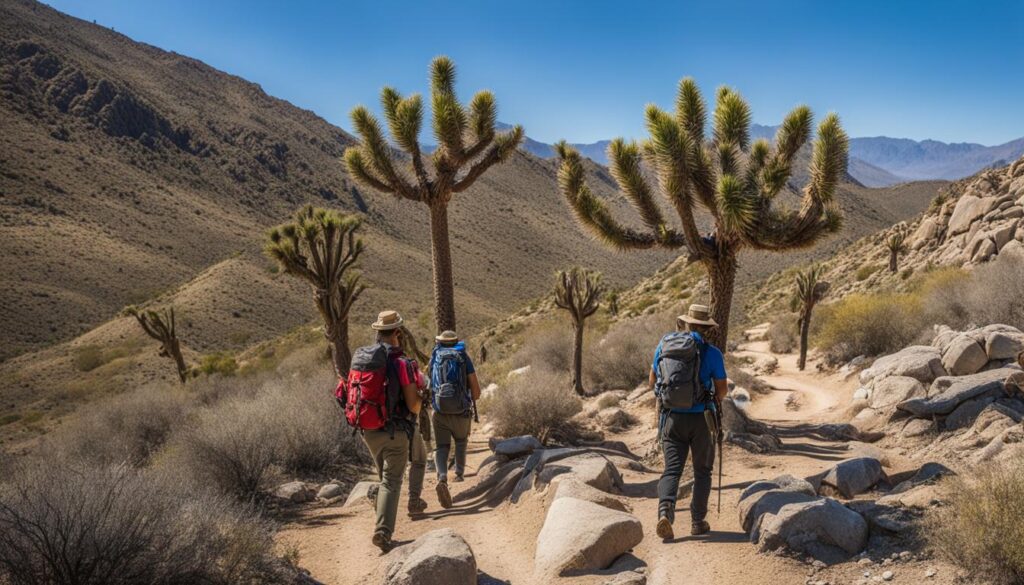
Hiking in Joshua Tree National Park is a thrilling and rewarding experience, but it’s important to prioritize your safety to ensure an enjoyable journey. Here are some essential safety tips to keep in mind before hitting the trails:
1. Inform someone about your hiking plans
Prior to heading out on your hike, make sure to inform a friend or family member about your plans. Share details such as the trail you’ll be hiking, your expected return time, and any specific landmarks or areas you plan to visit. This way, if you encounter any difficulties or are unexpectedly delayed, someone will have knowledge of your whereabouts.
2. Bring plenty of food and water
Hydration and nutrition are key when hiking in the desert environment of Joshua Tree. Make sure to bring an ample supply of water, as temperatures can be high, especially during the summer months. It’s recommended to carry at least one gallon of water per person per day. Additionally, pack enough food to keep your energy levels up throughout the hike.
3. Rest in the shade and avoid hiking during the hottest hours of the day
Seek shade whenever possible to rest and cool down during your hike. The desert sun can be intense, so it’s essential to take breaks in shaded areas to prevent heat exhaustion or heatstroke. It’s also advisable to avoid hiking during the hottest hours of the day, typically between 10 am and 4 pm. Plan your hikes for early morning or late afternoon when the temperatures are cooler.
4. Familiarize yourself with the park’s emergency contact information
Before embarking on your hike, take the time to familiarize yourself with the park’s emergency contact information. This may include the nearest ranger station or visitor center, as well as the park’s emergency hotline. In case of an emergency or if you require assistance, having this information readily available can be invaluable.
By following these safety tips, you can enjoy the breathtaking beauty of Joshua Tree National Park while ensuring your well-being throughout your hiking adventure.
Nearby Camping for Joshua Tree Hiking
If you’re planning a hiking adventure in Joshua Tree National Park, camping near the park can provide an immersive and convenient experience. There are several campgrounds located in the vicinity of the park, offering a range of amenities and facilities to ensure a comfortable stay. Whether you prefer a rustic camping experience or a more developed campground, there are options to suit every camper’s preferences.
Some popular campgrounds near Joshua Tree National Park include:
- Jumbo Rocks Campground: This campground is known for its stunning rock formations and spacious campsites. It offers basic amenities such as pit toilets and picnic tables, and it is a great choice for those seeking a more secluded camping experience.
- Hidden Valley Campground: Located near some of the park’s most iconic rock formations, Hidden Valley Campground is a favorite among climbers. It offers pit toilets, picnic tables, and a peaceful atmosphere.
- Black Rock Campground: Situated on the northern side of the park, Black Rock Campground provides easy access to hiking trails and stunning desert views. It offers amenities such as flush toilets, drinking water, and picnic tables.
These campgrounds provide an excellent opportunity to combine your hiking adventures with a camping experience, allowing you to fully immerse yourself in the beauty of Joshua Tree National Park.
Conclusion
Joshua Tree National Park offers a wealth of opportunities for hiking enthusiasts of all skill levels. Whether you’re a beginner or an experienced hiker, you’ll find trails that cater to your interests and abilities. By planning your trip carefully, considering seasonal variations, and prioritizing safety, you can have an unforgettable hiking experience in this unique desert landscape.
During your visit to Joshua Tree National Park, be sure to explore the easy hiking trails that are perfect for beginners or those looking for a more relaxed experience. These trails, such as the Arch Rock Trail and Barker Dam Trail, offer scenic views and opportunities to observe desert wildlife.
If you’re up for a challenge, tackle the park’s more challenging hiking trails. Trails like the Boy Scout Trail and Warren Peak Trail offer breathtaking views and an opportunity to explore remote areas of the park.
Remember to dress appropriately for the weather, bring plenty of water, and inform someone about your hiking plans. By taking these precautions, you can fully enjoy the beauty of Joshua Tree National Park while ensuring your safety.
Table: Recommended Hiking Trails in Joshua Tree National Park
| Difficulty | Trail Name | Distance | Estimated Time |
|---|---|---|---|
| Easy | Arch Rock Trail | 0.5 miles | 30 minutes |
| Easy | Bajada Trail | 2.4 miles | 1 hour |
| Easy | Barker Dam Trail | 1.3 miles | 1 hour |
| Challenging | Boy Scout Trail | 16 miles | 8 hours |
| Challenging | Lost Horse Mine Trail | 6.3 miles | 3 hours |
| Challenging | Warren Peak Trail | 5.3 miles | 4 hours |
Joshua Tree Hiking Essentials: Top Trails and Seasonal Tips
Welcome to Section 12, the final part of our guide to Joshua Tree hiking! In this section, I will summarize the key essentials, top trails, and seasonal tips you need to know for an unforgettable hiking experience in Joshua Tree National Park.
Essentials of Joshua Tree Hiking
When preparing for your Joshua Tree hiking adventure, there are a few essentials you should keep in mind. First and foremost, research and plan your trip carefully. Consider the difficulty level and length of the trails, as well as the specific season you’ll be visiting. Be sure to bring plenty of water, as staying hydrated is crucial in the desert environment. Additionally, wear appropriate clothing and footwear, and don’t forget essentials like a map, sunscreen, and a first-aid kit.
Top Trails to Explore
Joshua Tree National Park is home to a variety of incredible hiking trails. Some of the top trails to explore include the Arch Rock Trail, which leads you through a unique rock formation, and the Barker Dam Trail, where you can discover ancient petroglyphs and a scenic desert oasis. Other popular trails include the Hidden Valley Trail, Ryan Mountain Trail, and Lost Horse Mine Trail. Each of these trails offers its own unique beauty and opportunities to connect with nature.
Seasonal Tips for Hiking
Understanding the seasonal conditions in Joshua Tree National Park is crucial for a safe and enjoyable hiking experience. During the summer months, temperatures can soar, so it’s best to hike early in the morning or in the late afternoon to avoid the hottest hours of the day. In winter, be prepared for colder temperatures, especially during the evenings. Spring and fall are generally the best times to visit, as the weather is milder. Keep an eye on the park’s website for any trail closures or alerts related to weather conditions.
That wraps up our guide to Joshua Tree hiking essentials, top trails, and seasonal tips. I hope this information has been helpful in planning your adventure. Now it’s time to lace up your hiking boots, hit the trails, and immerse yourself in the breathtaking beauty of Joshua Tree National Park!
FAQ
What are some easy hiking trails in Joshua Tree National Park?
Some easy hiking trails in Joshua Tree National Park include the Arch Rock Trail, Bajada Trail, and Barker Dam Trail.
What are some challenging hiking trails in Joshua Tree National Park?
Some challenging hiking trails in Joshua Tree National Park include the Boy Scout Trail, Lost Horse Mine Trail, and Warren Peak Trail.
What are the seasonal differences in hiking conditions in Joshua Tree National Park?
In the summer, temperatures can exceed 105 degrees Fahrenheit, so it’s best to avoid hiking between 10 am and 5 pm. Winter offers cooler temperatures, but nights can be freezing. Spring and fall are considered the peak seasons for comfortable hiking conditions.
What historical significance and geological wonders can be found in Joshua Tree National Park?
Joshua Tree National Park is home to Native American cultural sites, old mining structures, and remnants of early ranching operations. The park also showcases unique geological formations, including towering Joshua Trees, massive boulder piles, and panoramic vistas.
What wildlife can be found in Joshua Tree National Park?
Visitors to Joshua Tree National Park can spot a variety of desert-dwelling animals, including desert tortoises, kangaroo rats, bighorn sheep, and numerous bird species.
What are some scenic viewpoints in Joshua Tree National Park?
Some popular scenic viewpoints in Joshua Tree National Park include Keys View, Ryan Mountain, and High View Trail. These viewpoints offer panoramic views of the desert landscape, rock formations, and distant mountain ranges.
How should I plan my hiking trip to Joshua Tree National Park?
Before your hike, research the trail you plan to explore and check weather conditions. Inform someone about your hiking plans, bring essential items like a map, plenty of water, appropriate clothing, a first-aid kit, and navigation tools.
What safety tips should I keep in mind when hiking in Joshua Tree National Park?
Prioritize your safety by informing someone about your hiking plans, bringing plenty of food and water, resting in the shade, avoiding the hottest hours of the day, and familiarizing yourself with the park’s emergency contact information.
Are there campgrounds near Joshua Tree National Park?
Yes, there are several campgrounds near Joshua Tree National Park, including Jumbo Rocks Campground, Hidden Valley Campground, and Black Rock Campground.
How can I have an unforgettable hiking experience in Joshua Tree National Park?
By planning your trip carefully, considering seasonal conditions, and taking necessary safety precautions, you can have an unforgettable hiking experience in Joshua Tree National Park.

